6 Major Ports of Israel
The State of Israel is situated in Western Asia bordering the Mediterranean and the Red seas. Despite its location amidst the politically turbulent countries of Syria, Egypt and its proximity to the Gaza strip, Israel is recognised as a powerful country playing an active role in global geopolitics. It was categorised as a high-income economy by the World Bank and has a well-developed technological and industrial sector.
It also boasts a strong commercial shipping sector comprising 6 major ports and oil terminals. Let us have a look at the distinguishing features of these facilities.
1. Port of Haifa
Haifa is the principal port of Israel, handling around 30 million tons of cargo and over 2 million passengers every year. Possessing a natural, well-sheltered harbour, it is one of the biggest ports in the eastern Mediterranean region. It is situated on the northern Mediterranean coast near Haifa Bay and is surrounded by two breakwaters.
Covering more than 4,550,000 m2, Haifa port handles diverse cargoes and offers an array of services. It exports citrus fruits, tyres, textiles and machinery and receives shipments of grains, oil and petroleum and raw material. Industrial and commercial activities are concentrated a few kilometres from the port facility.

Bestowed with the title of the most efficient port of Israel by the OECD, Haifa is at par with international port standards. It consists of numerous cargo terminals capable of serving many vessels simultaneously. Haifa port has the latest port infrastructure that eases operations and prevents congestion. For instance, it has an 18-lane truck gate that allows several cargo vehicles to exit the premises at once. It also has a fishing port, a boat club, a water sports marina and a dedicated chemical berth.
Operated by the Haifa Port Company, it is an engine that propels the growth of the nation’s economy. It is not only a cargo port but also caters to the general public by organising movie screenings, grand events, live musical performances and exhibitions at the famous Warehouse 15.
Passenger terminal
This facility serves both cruise ships and ferries and is the only terminal in Israel from where holiday cruises depart for the Mediterranean. The terminal is decked with world-class facilities and is fully air-conditioned. It has numerous waiting rooms, duty-free shops, souvenir shops, a large cafeteria, a currency exchange counter, free wifi, and a large car park for sailors.
Directly connected to the lower city of Haifa, the Haifa Railway Station and the central bus stop are also adjacent to this facility. The terminal has expanded considerably and is the only one in Israel that receives luxury ships and cruises with more than 5000 passengers on board.
Carmel Terminal
The Container terminal of Haifa port is the biggest in Israel and one of the most technologically advanced facilities. The green terminal was opened in 2010 however it became operational in the latter part of 2011. It can handle more than 1 million TEUs annually and set a new record in 2020 as container throughput increased by six per cent to 1.47 million TEUs.This great feat was a result of the fast container processing and shorter waiting times, thereby increasing the port output.
Spanning 700 m with a water depth of approximately 16 m, the terminal can handle container ships with a capacity of 15,300 TEUs. It is also decked with the latest port equipment such as the world’s biggest 8 bridge cranes, capable of lifting two 35 tonne containers at once. The terminal can unload two container ships simultaneously and comprises 5000 compartments for keeping containers. Around 25,000 containers can be stored in the stacking area with the aid of 15 gate cranes.
2. Port of Ashdod
Opened in 1965, the Ashdod port lies at the mouth of the Nahal Lakhish river just 40 kilometres from Tel Aviv. It is the second major commercial port of Israel, handling bulk cargoes, roro, containerised goods, and oil tankers. It exports chemicals, fertilisers, citrus fruits, manufactured goods and imports grain, coal, general cargo and automobiles. Approximately 2500 ships, 19,000,000 tonnes of cargo and over 1 million TEUs are handled at the port annually.
Its strategic location near Israel’s commercial centres and national transportation networks has transformed it into a busy facility. It has been expanded to accommodate Panamax ships and major shipping companies operate from Ashdod.
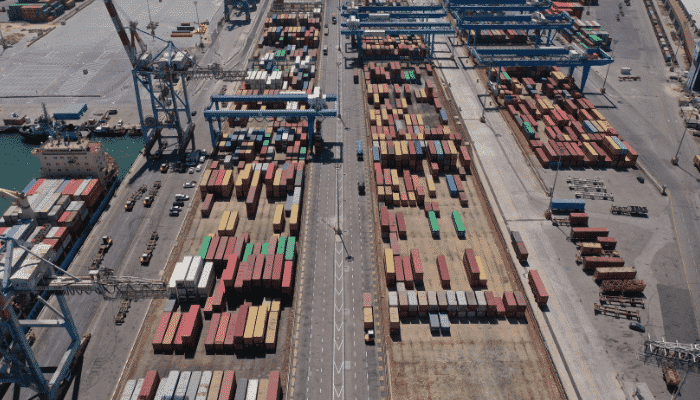
The port city is famous for its oil refinery, one of the largest in Israel. It also houses pharmaceutical companies and construction industries. Radar equipment and electronic warfare gadgets are also manufactured here.
Ashdod port has 50,000 m2 of covered storage area including a 2800 m2 warehouse for keeping hazardous chemicals.
Container terminal
The Eitan port became operational in 2006 and is an extension of Ashdod. It handled around 1.58 million TEUs in 2020. Constructed by extending the eastern breakwater by 1550 m and reclaiming 110 hectares, the facility has several docks with a total quay length of over 1650 m, capable of berthing super post-Panamax ships.
General Cargo terminal
This facility comprises six conventional wharves that handle agricultural commodities, timber, metals, pelletised and sling cargo etc. Ships weighing up to 30,000 DWT can enter this terminal. On its opposite side are 4 RoRo piers with inbuilt ramps for accommodating RoRo carriers.
Coal berth
Bulk shipments of coal are received at the coal pier located near the power station. Dock 9 was constructed in 1989 which allows the unloading of more than 2 million tonnes of coal each year.
Mineral berth
The Mineral wharf became operational in 1967 and comprises multiple silos and tanks for keeping over 2 million tonnes of phosphates and 130,000 tonnes of potash. The vessels carrying potash are moored at the dolphins with an alongside depth of 12 m.
Grain terminal
A 3-kilometre long, grain conveyor system is being built at this terminal to transport wheat from the docks to the port’s silos. It is expected to increase the handling capacity of the terminal.
South Terminal
The construction work for the new South Terminal commenced in 2015. It was envisaged as a sub-port of the larger Ashdod. Excessive container traffic could be diverted to this facility and it could handle some general cargo as well. With this plan, the Israel Ports Authority constructed two breakwaters, and a container terminal with an 850 m long quay for handling around 17,500 TEUs. Construction of cargo storage facilities and a logistics centre is also underway.
3. Port of Eilat
Eilat port is located near the Aqaba Gulf in the Red Sea. It can handle various types of cargo and also offers ship maintenance and repair services. Opened in 1955, it is mainly utilised for receiving vehicle imports from the Far East nations. Eilat offers a shorter shipping route as ships sailing from Israel can reach the Indian Ocean without passing through the Suez Canal. It was privatised in 2019 and is being developed to attract new business from its international clients.
Minerals, phosphates, potash and ores are exported from Eilat worldwide. It deals with imports of timber, construction material, foodstuff and automobiles. Around 2,110,000 tonnes of dry cargo, 75,000 vehicles and more than 50,000 TEUs are handled at this facility annually. In 2018, it handled 176,000 tonnes of general cargo and 104,950 vehicles.
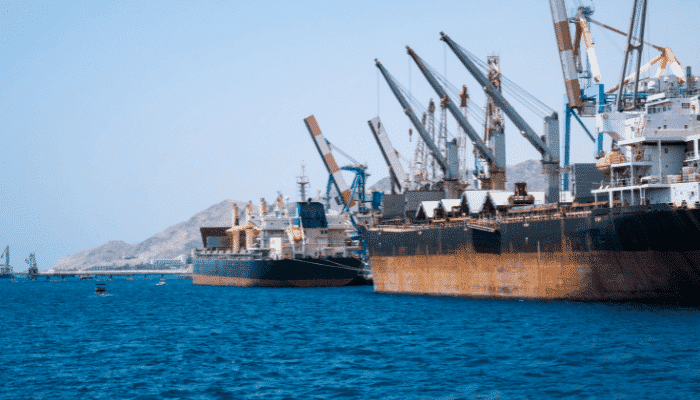
Counted among the three biggest ports of Israel, it has witnessed a gradual decrease in the volume of cargo traffic over the years. Lower ship traffic is a consequence of the port’s great distance from the commercial and industrial centres of Israel. Another reason is that unlike the ports of Haifa and Ashdod, Eilat is not directly linked to the national railway network.
Presently, the port consists of a conventional berth covering 530 m with a water depth of 9.5 m and three berthing tugs. The port equipment is in good condition and includes a bridge crane capable of lifting 70 tonnes, 2 shore cranes and 2 gate cranes.
4. Port of Tel Aviv
Locally known as Namal Tel Aviv, it is a famous commercial centre and a pleasure port capable of accommodating a few yachts. Tel Aviv port was established in 1936 by a Jew named Otzar Mif’alei Yam, as the first port of Israel after the closure of the old Jaffa port, a consequence of the Arab Revolt of the 1930s. Tel Aviv became operational in 1938 with a functioning dock for receiving small ships and fishing vessels. However, with the advent of container shipping in the late 1900s, the port was deserted as larger ports were built in the country.
Between 2002 to 2008, the port buildings were restored and the infrastructure was redesigned to convert it into an entertainment hub. The old ship hangars were transformed into halls, exhibition and art galleries, boutiques and meeting rooms. Interestingly, during the day, Tel Aviv is bustling with crowds of shoppers, while at night it is transformed into a vibrant nightlife spot.
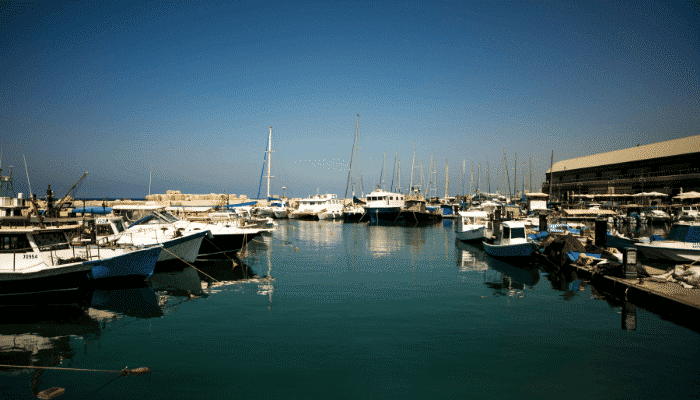
Today, the Tel Aviv port comprises a modern wooden deck spanning over 14,500 square metres, covering the entire waterfront. It is lined with seating areas and is one of the best places to enjoy sunsets.
The port is also famous for its small indoor market selling locally produced fruits and vegetables. During the day, there are many food stalls offering varieties of fresh seafood. It is popular for its coffee parlours offering traditional Jewish coffee and multicuisine restaurants.
5. Port of Hadera
Hadera port is situated in the northern part of Israel, close to the cities of Tel Aviv and Haifa. It is a medium-sized facility comprising a coal and fuel oil terminal serving the region’s two main power stations. It consists of a 2200 m oil jetty, an automated coal conveyor system fed by 2 grabs and a multi buoy offshore oil tanker berth for receiving shipments of fuel oil. Approximately 7,000,000 tonnes of cargo is handled at the Hadera port every year.
The coal berth spans 600 m and can easily accommodate coal carriers weighing around 200,000 DWT, with a draught of 18 m. Oil tankers up to 70,000 DWT can be berthed at the oil terminal.
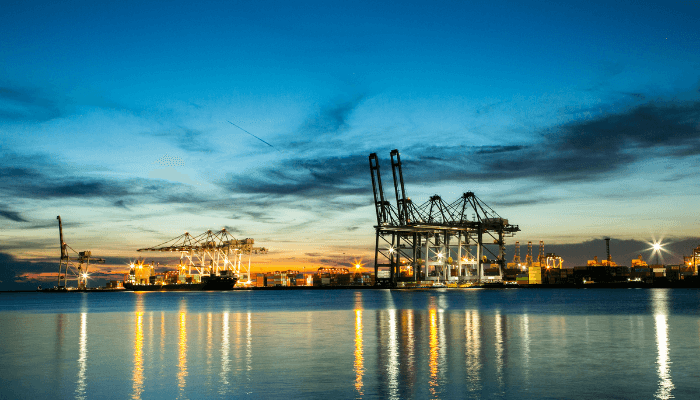
The port city is also famous for the Hadera Paper Enterprise established in 1953. It also houses one of the world’s biggest desalination plants. Israel’s main power station, the Orot Robin Power plant is located near the port facility.
6. Port of Ashkelon
The Ashkelon oil terminal lies 2 nautical miles from the town of Ashkelon and 10 miles from Ashdod. Operated by the Eilat Ashkelon Pipeline Company, it is a major port dealing in petroleum products and derivatives. The facility serves the industrial region of Israel and receives more than 1000 ships every year.

It comprises three CBM berths for discharging white products and handling fuel oil, LPG, gasoline etc. These can accommodate tankers weighing around 80,000 DWT with a draught of 17 m and a 250 m LOA. It also consists of 2 Single point mooring buoys for accommodating VLCC size crude oil carriers weighing over 250,000 DWT. The 350 m long coal jetty receives 200,000 DWT coal carriers with a draught of 18 m.
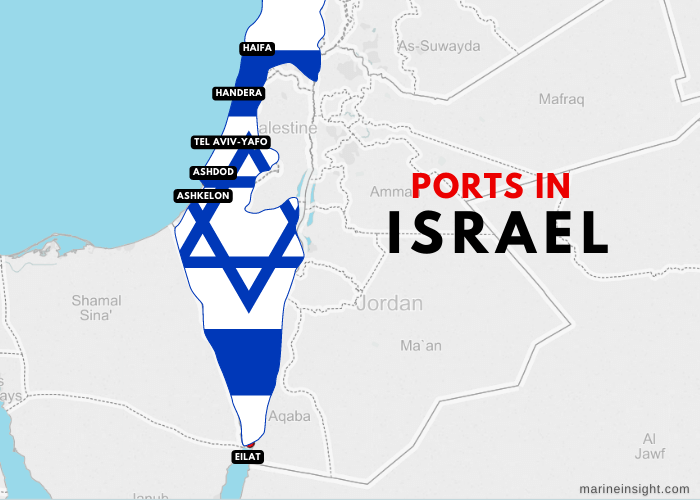
You might also like to read:
- 5 Major Ports in Bahrain
- What Are The Major Ports In Jordan?
- Major Ports In Lebanon
- 5 Major Ports in Libya
- 7 Major Ports in Kazakhstan
Disclaimer :
The information contained in this website is for general information purposes only. While we endeavour to keep the information up to date and correct, we make no representations or warranties of any kind, express or implied, about the completeness, accuracy, reliability, suitability or availability with respect to the website or the information, products, services, or related graphics contained on the website for any purpose. Any reliance you place on such information is therefore strictly at your own risk.
In no event will we be liable for any loss or damage including without limitation, indirect or consequential loss or damage, or any loss or damage whatsoever arising from loss of data or profits arising out of, or in connection with, the use of this website.
Do you have info to share with us ? Suggest a correction
Disclaimer :
The information contained in this website is for general information purposes only. While we endeavour to keep the information up to date and correct, we make no representations or warranties of any kind, express or implied, about the completeness, accuracy, reliability, suitability or availability with respect to the website or the information, products, services, or related graphics contained on the website for any purpose. Any reliance you place on such information is therefore strictly at your own risk.
In no event will we be liable for any loss or damage including without limitation, indirect or consequential loss or damage, or any loss or damage whatsoever arising from loss of data or profits arising out of, or in connection with, the use of this website.

About Author
Shilavadra Bhattacharjee is a shipbroker with a background in commercial operations after having sailed onboard as a Third Officer. His interests primarily lie in the energy sector, books and travelling.
Latest Maritime Knowledge Articles You Would Like:
Subscribe To Our Newsletters
By subscribing, you agree to our Privacy Policy and may receive occasional deal communications; you can unsubscribe anytime.















